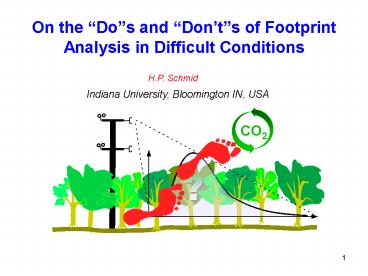On the - PowerPoint PPT Presentation
1 / 18
Title: On the
1
On the Dos and Donts of Footprint Analysis
in Difficult Conditions
2
The earliest documented footprint-type idea
The Effective Fetch of Frank Pasquill (1972)
Pasquill, F. 1972. 'Some aspects of boundary
layer description'. Q. J. R. Meteorol. Soc., 98,
469-494.
Frank Pasquill, FRS1914 - 1994
3
Effective fetch isopleths (C/Cmax ½) dependent
on height, stability and roughness
4
In the time since Pasquill Several Types of
Footprint Models
- Analytical
- Stochastic (Lagrangian)
- Closure Models
- Large-Eddy Simulation
- For reviews of individual models, see
- Schmid, Ag.For.Met., 113, 2002 159-183.
- Foken Leclerc, Ag.For.Met, 127, 2004 223-234.
5
Flux Footprint spatial filter, field of view
(convolution of the source distribution, QS, with
the footprint, f )
? scalar flux, F or scalar concentration, c
6
Concentration and Flux Footprint Models
Governing equations in Eulerian analysis
advection
diffusion
forcing
F
in inhomogeneous flow, may cause complex behavior
of flux footprint
following Finnigan (2004, AgForMet 127,
117-129) neglecting horizontal turbulent fluxes
and pressure interactions.
7
Analytical Footprint Models
Aad van Ulden (1978)
Realistic analytic solution of advection-diffusion
equation
- based on power-law profiles
- fitting power-laws to similarity profiles
- M-O scaling
widely used for analytic source area and
footprint models (with some exceptions!)
Van Ulden, A.P., 1978. Simple estimates for
vertical diffusion from sources near the ground,
Atmos. Environ., 12, 2125-2129.
8
Lagrangian Stochastic Footprint Models
Joseph-Louis Lagrange (1736-1813)
Paul Langevin(1872-1946)
- need large number of particles
- need flow and turbulence
- adaptable to vertically inhomogeneous turbulence
(e.g., forest canopies)
Continuous Point Source
9
Forest Canopy LS-Footprint Models
Dennis D. Baldocchi
- forward well-mixed LS model (2-D, 3D)
- parameterized turbulence/flow profiles
- vertically inhomogeneous turbulence
- includes streamwise diffusion
Baldocchi, D.D., Ag. For. Met. 85, 1997
273-292.
10
Usage of Analytical (forward) LS-Models
- motivated by spatial inhomogeneity (in the
scalar field) - assume horizontal homogeneity (in flow and
turbulence)
invalid !
Point Source
Virtual Source
11
Alternatives for Inhomogeneous Flow
Footprint computation based on full (Eulerian)
flow models (plus scalar transport equation or
LS-module)
Claude Louis Marie Henri Navier (1785-1836)
- Closure Models
- LES Models
George Gabriel Stokes (1819-1903)
Depending on resolution and closure / sub-grid
scale treatment
James W. Deardorff (born 1928)
- can be made applicableto any complex condition
- can be computationally very intensive
Monique Y.Leclerc (born...not long ago)
These models are not footprint models per se, but
full flow models used to compute a footprint.
12
Alternatives for Inhomogeneous Flow
- Backward LS-Model
applicable in principle, but has never been done
to date
Sensor continuous backward release point
Direct Footprint
Touchdown Source Locations
- no Inverse Plume Assumption needed
- applicable in weakly inhomogeneous canopies
13
Objective Examine Applicability of Footprint
Model Types in Difficult Conditions
Difficult Conditions ???
? deviations from micrometeorological ideal
- flat terrain
- homogeneous fetch
- low, homogeneous vegetation (if any)
- stationarity
- well-developed turbulence (MOST)
- topography
- patchy land-cover
- deep, multy-layer vegetation canopy
- instationarity
- weak turbulence free convection
14
Flux Measurement in Difficult Conditions
and Footprint Modeling in Difficult Conditions
Micrometeorologists traditional knee-jerk
reaction Stay away from it!
15
Difficult Conditions Patchy Land Cover
HeterogeneousScalar Field (DLAI, DBowen-Ratio)
- non-difficult condition
- any footprint model applies
- analytic models have restriction to MOST
HeterogeneousFlow/Turbulence (disturbance,
forest edges)
- inverse plume assumption (analytical, forward
LS) does not apply - full flow model needed
- case poorly understood
16
Difficult Conditions Deep Canopies
Tall Trees
- analytical models apply only if zm gt 2h (Rannik
et al. 2000) - forest model better
- sensitive to turbulence profiles
- forest model needed
- sensitive to turbulence profiles
- inverse plume assumption (horizontal
homogeneity) questionable
Multi-Layer Understorey
17
Difficult Conditions Topography
Large Scale Topography
- use footprint model only (with caution!) for
small zm/h local footprint - use footprint model only for qualitative analysis
- full flow model is preferred
Small Scale, Gentle Topography
- use footprint model if terrain following flow can
be assumed (stable conditions?) - inverse plume assumption???
- use footprint model only for qualitative analysis
18
- Know the site!
- Know the model!
- Know the assumptions!
- Thou shall not use a model outside its
applicability range! - Thou shall not call it footprint if the model
does not use unit source strength! - Thou shall not invert a footprint model to
estimate a flux! - Thou shall not use a scalar footprint model for
non-scalars! - Thou shall exercise caution when using a
footprint model with non-passive scalars! - Thou shall never blindly believe any footprint
model result, but examine it in the context of
the site (see I.)! - Thou shall not complain that there are only nine
commandments!































